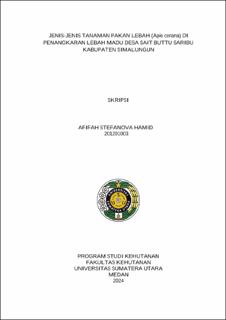Jenis-Jenis Tanaman Pakan Lebah (Apis cerana) di Penangkaran Lebah Madu Desa Sait Buttu Saribu Kabupaten Simalungun
Types of Bee Feed Plants (Apis cerana) in Honey Bee Breeding Sait Buttu Saribu Village Simalungun Regency

Date
2024Author
Hamid, Afifah Stefanova
Advisor(s)
Widyastuti, Dwi Endah
Metadata
Show full item recordAbstract
Indonesia is a tropical country with 25,000 types of flowering plants in the form of agricultural crops, plantations, forests, shrubs, grasses and flowers that can produce nectar and pollen which have the potential to be used as honey bee feed and are widely spread over an area of 200 million hectares. This study aims to identify the types of honey bee feed plants (Apis cerana) and determine the flowering schedule of nectar and pollen producing plants as a source of honey bee feed at the Honey Coffee Taro Honey Bee Breeding Tourism Education, Sait Buttu Saribu Village, Pamatang Sidamanik District, Simalungun Regency. The research was carried out by observation methods and literature studies. The identification results showed that there were 28 types of bee feed plants with a total of 1.251 individuals, consisting of 13 types of agricultural plants, 3 types of forestry plants, and 12 types of ornamental plants and grasses. The flowering schedule of bee feed plants at the study site varied, with 9 types of flowering plants throughout the year, 3 types of seasonal flowering plants, and 16 other types with varying flowering times. The availability of diverse beefeed plants and varied flowering schedules at the Honey Taro Coffee Honey Bee Breeding Tourism Education can support the sustainability and productivity of the Apis cerana bee colony. The results of this study are expected to be information and references for the development of honey bee cultivation in similar locations.
Collections
- Undergraduate Theses [2162]
